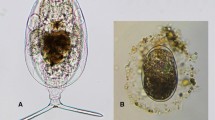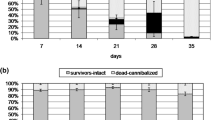Abstract
Feeding, growth, and reproductive responses of the suspension-feeding protozoanTetrahymena pyriformis to shifts up or down of the density of its bacterial food were observed. The rates of feeding, growth, and reproduction were determined by measuring the rates of uptake of viable bacterial cells, of change of mean volume of the protozoan cells, and of change of number of protozoan cells, respectively. The effects of the nutritional status of the protozoans at the time of shifting were observed also. Results are interpreted in terms of the limited polymorphism exhibited in the life cycle of this organism. Responses in all cases seem to reflect a strategy for exploiting a patchy, transient environment, a conclusion already reached by several earlier investigators.
Similar content being viewed by others
References
Alexander M (1981) Why microbial predators and parasites do not eliminate their prey and hosts. Ann Rev Microbiol 35:113–133
Ashby RE (1976) Long term variations in a protozoan chemostat culture. J Exp Mar Biol Ecol 24:227–235
Bader FG, Tsuchiya HM, Fredrickson AG (1976) Grazing of ciliates on blue-green algae. Effects of ciliate encystment and related phenomena. Biotechnol Bioeng 18:311–332
Barna I, Weis DS (1973) The utilization of bacteria as food forParamecium bursaria. Trans Am Microsc Soc 92:434–440
Bazin MJ, Rapa V, Saunders PT (1974) The integration of theory and experiment in the study of predator-prey dynamics. In: Usher MB, Williamson MH (eds) Ecological stability. Chapman and Hall, London, pp 159–164
Berk SG, Colwell RR, Small EB (1976) A study of feeding responses to bacterial prey by estuarine ciliates. Trans Am Microsc Soc 95:514–520
Butterfield CT, Purdy WC (1931) Some interrelationships of plankton and bacteria in natural purification of polluted water. Ind Eng Chem 23:213–218
Cameron IL (1965) Macromolecular events leading to cell division inTetrahymena pyriformis after removal and replacement of required pyrimidines. J Cell Biol 25 (Part 2):9–18
Canale RP, Lustig TD, Kehrberger PM, Salo JE (1973) Experimental and mathematical modeling studies of protozoan predation on bacteria. Biotechnol Bioeng 15:707–728
Chapman-Andresen C, Nilsson JR (1968) On vacuole formation inTetrahymena pyriformis GL. C. r. Trav. Lab. Carlsberg 36:405–432
Coleman GS (1964) The metabolism ofEscherichia coli and other bacteria byEntodinium caudatum. J Gen Microbiol 37:209–223
Corliss JO (1953) Comparative studies on holotrichous ciliates in theColpidium-Glaucoma-Leucophrys-Tetrahymena group. II. Morphology, life cycles and systematic status of strains in pure culture. Parasitology 43:49–87
Curds CR, Bazin MJ (1977) Protozoan predation in batch and continuous culture. Adv Aquatic Microbiol 1:115–176
Curds CR, Cockburn A (1968) Studies on the growth and feeding ofTetrahymena pyriformis in axenic and monoxenic culture. J Gen Microbiol 54:343–358
Curds CR, Cockburn A (1971) Continuous monoxenic culture ofTetrahymena pyriformis. J Gen Microbiol 66:95–108
Curds CR, Vandyke JM (1966) The feeding habits and growth rates of some fresh water ciliates found in activated sludge. J Appl Ecol 3:127–137
Dent VE, Bazin MJ, Saunders PT (1976) Behaviour ofDictyostelium discoideum amoebae andEscherichia coli grown together in a chemostat culture. Arch Microbiol 109:187–194
Dive D (1973) Nutrition holozoique deColpidium campylum. Phenomenes de selection et d'antagonisme avec les bacteries. Water Res 7:695–706
Dive D (1975) Influence de la concentration bacterienne sur la croissance deColpidium campylum. J Protozool 22:545–550
Drake JF, Tsuchiya HM (1976) Predation onEscherichia coli byColpoda steinii. Appl Environ Microbiol 31:870–874
Drake JF, Tsuchiya HM (1977) Growth kinetics ofColpoda steinii onEscherichia coli. Appl Environ Microbiol 34:18–22
Fenchel T (1980) Suspension feeding in ciliated protozoa: Functional response and particle size selection. Microb Ecol 6:1–11
Fenchel T (1980) Suspension feeding in ciliated protozoa: Feeding rates and their ecological significance. Microb Ecol 6:13–25
Gause GF (1934) The struggle for existence. Williams and Wilkins, Baltimore, Maryland
Habte M, Alexander M (1978) Protozoan density and the coexistence of protozoan predators and bacterial prey. Ecology 59:140–146
Hamilton RD, Preslan JE (1970) Observations on the continuous culture of a planktonic phagotrophic protozoan. J Exp Mar Biol Ecol 5:94–104
Harding JP (1937) Quantitative studies on the ciliateGlaucoma: I. The regulation of the size and fission rate by the bacterial food supply. J Exp Biol 14:422–430
Harding JP (1937) Quantitative studies on the ciliateGlaucoma: II. The effects of starvation. J Exp Biol 14:431–439
Jost JL, Drake JF, Fredrickson AG, Tsuchiya HM (1973) Interactions ofTetrahymena pyriformis, Escherichia coli, Azotobacter vinelandii, and glucose in a minimal medium. J Bacteriol 113:834–840
Laybourn JEM, Stewart JM (1975) Studies on consumption and growth in the ciliateColpidium campylum Stokes. J Animal Ecol 44:165–174
Luckinbill LS (1973) Coexistence in laboratory populations ofParamecium aurelia and its predatorDidinium nasutum. Ecology 54:1320–1327
Luckinbill LS (1974) The effects of space and enrichment on a predator-prey system. Ecology 55:1142–1147
Luckinbill LS (1979) Regulation, stability, and diversity in a model experimental microcosm. Ecology 60:1098–1102
Proper G, Garver J (1966) Mass culture of the protozoaColpoda steinii. Biotechnol Bioeng 8:287–296
Ratnam DA, Pavlou S, Fredrickson AG (in press) Effects of attachment of bacteria to chemostat walls in a microbial predator-prey relation. Biotechnol Bioeng
Ricketts TR, Rappitt AF (1974) Determination of the volume and surface area ofTetrahymena pyriformis, and their relationship to endocytosis. J. Protozool 21:549–551
Salt GW (1967) Predation in a experimental protozoa population (Woodruffia-Paramecium), Ecolog Monogr 37:113–144
Salt GW (1975) Changes in the cell volume ofDidinium nasutum during population increase. J Protozool 22:112–115
Sudo R, Kobayashi K, Aiba S (1975) Some experiments and analysis of a predator-prey model: Interaction betweenColpidium campylum andAlcaligenes faecalis in continuous and mixed culture. Biotechnol Bioeng 17:167–184
Swift ST, Najita IY, Ohtaguchi K, Fredrickson AG (1982) Continuous culture of the ciliateTetrahymena pyriformis onEscherichia coli. Biotechnol Bioeng 24:1953–1964
Taylor WD (1978) Growth responses of ciliate protozoa to the abundance of their bacterial prey. Microb Ecol 4:207–214
Taylor WD, Berger J (1976) Growth ofColpidium campylum in monoxenic batch culture. Can J Zool 54:392–398
Taylor WD, Berger J (1976) Growth responses of cohabiting ciliate protozoa to various prey bacteria. Can J Zool 54:1111–1114
Taylor WD, Gates MA, Berger J (1976) Morphological changes during the growth cycle of axenic and monoxenicTetrahymena pyriformis. Can J Zool 54:2011–2018
Tsuchiya HM, Drake JF, Jost JL, Fredrickson AG (1972) Predator-prey interactions ofDictyostelium discoideum andEscherichia coli in continuous culture. J Bacteriol 110:1147–1153
van den Ende P (1973) Predator-prey interactions in continuous culture. Science 181:562–564
Villareal E, Canale RP, Akcasu Z (1975) A multigroup model for predator-prey interactions. Biotechnol Bioeng 17:1269–1290
Watson PJ, Ohtaguchi K, Fredrickson AG (1981) Kinetics of growth of the ciliateTetrahymena pyriformis onEscherichia coli. J Gen Microbiol 122:323–333
Williams FM (1971) Dynamics of microbial populations. In: B. C. Patten (ed.). Systems analysis and simulation in ecology, Vol. 1. Academic Press, New York and London, pp 197–267
Author information
Authors and Affiliations
Rights and permissions
About this article
Cite this article
Swift, S.T., Najita, I.Y., Ohtaguchi, K. et al. Some physiological aspects of the autecology of the suspension-feeding protozoanTetrahymena pyriformis . Microb Ecol 8, 201–215 (1982). https://doi.org/10.1007/BF02011425
Issue Date:
DOI: https://doi.org/10.1007/BF02011425




